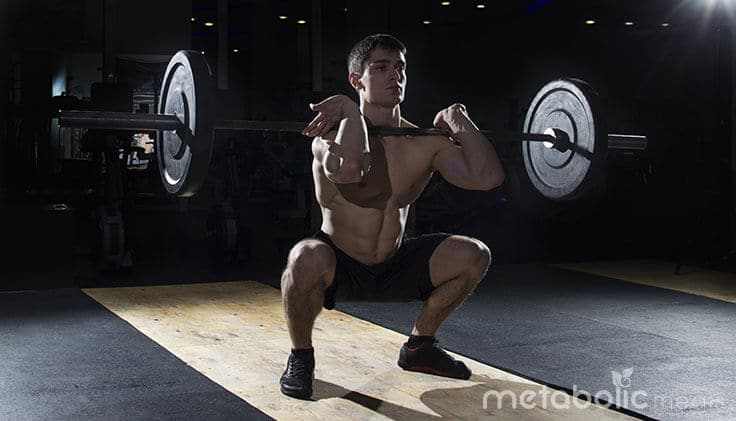ARTICLE AT A GLANCE
Athletes are unique individuals. The attributes necessary to succeed in a sport encompass much more than “God-given genetics.” Don’t get me wrong: There are certain attributes we can’t develop in the weight room, such as height or wingspan, and it’s true that those attributes can be great indicators of athletic potential. But other attributes can absolutely be developed in the weight room — and that is where hard work becomes the great equalizer.
Over the years, I’ve been fortunate to work with — and collect data on — thousands of Division 1 athletes. A handful of exercises have withstood the test of time and have continued to drive up performance indicators such as speed, vertical jump, and functional upper body strength, which is the strength necessary to succeed in the game.
More importantly, these same exercises also seem to be the greatest indicator of injury prevention. All the talent, strength, and skill in the world are absolutely worthless if you’re injured and sitting on the bench. The key to success is not only developing your abilities, but also staying healthy.
Staying in the Game
Before I divulge my top four exercises, I want to briefly discuss a concept known as dynamic correspondence. This term, coined by Yuri Verkhoshansky, refers to an exercise’s direct effect on sporting performance. Simply put, if all things were equal between two athletes — height, weight, speed, ability, etc. — then introducing a specific exercise to one of those athletes in training would provide a greater transfer of effect to actual performance in competition.
The key to efficient and effective training is to identify these exercises and incorporate them into training. Whether you’re a professional football player, a Division 1 soccer player, or a high school basketball player, here are my top four exercise recommendations for driving up transferability of training and keeping yourself in the game:
1. Front Squat

Of course, I had to mention squats right out of the gate. Front squats work because there’s no way to cheat the technique. A poorly executed front squat results in dropping the bar, whereas an incorrectly performed back squat can result in a rep with no carry-over to performance, or worse, a blown-out back. The front squat provides several benefits.
For the vast majority of athletes, improving the front squat will directly result in improvements in vertical leaping ability. That’s because the front squat is a quad-dominant exercise and improves vertical force production. In my weight room, we have a saying: “Squat go up, bounce go up!”
It’s impossible to properly execute a front squat without phenomenal ankle and hip mobility. Those lacking proper mobility can utilize weightlifting shoes or squat wedges to elevate the heels and allow the knee to push out over the toe. The range of motion I want my athletes to exhibit is the hamstring covering the gastrocnemius, closing the knee joint.
Injury prevention: The vastus medialis oblique, or VMO, is critical in preventing knee injuries and ensuring proper knee tracking. The top and bottom 15 percent of the squat is where the VMO is most engaged, and training only in the top 15 percent is an imbalance waiting to cause injury. If you lack the mobility to get into the bottom position and the strength to get back out of it, your knees are at risk. Try elevating your heels with a weightlifting shoe or squat wedge, then slowly wean yourself off it as you become more proficient.
2. Snatch-Grip Deadlift

The snatch-grip deadlift is one of the most underutilized deadlift variations, but it offers the best bang for your buck when it comes to developing posterior chain strength and horizontal force production. Like the front squat, snatch-grip deadlifts have a direct effect on performance — speed and muscle mass in particular.
For most athletes, improving snatch-grip deadlift performance will improve acceleration because the exercise works the posterior chain. The stronger your posterior chain, the faster you’ll be able to run.
As with the squat, it’s difficult to cheat a snatch-grip deadlift. And when you’re doing it right, every muscle you can’t see in the mirror will be screaming at you. From the top to the bottom, everything is engaged: your traps, upper back, lower back, erector spinae, glutes, hamstrings, and even your calves.
Injury prevention: For this exercise, the quads are the gas, and the posterior chain is the breaks. Having adequate strength in the muscles you don’t see in the mirror is critical to proper biomechanics during deceleration and landing. If the big muscles behind you aren’t strong enough to absorb the force, the ligaments in your knee are at risk.
3. Overhead Press

The overhead press is my go-to upper-body pressing exercise. Don’t get me wrong, the bench press is great; it’s merely my belief that long-term shoulder health is determined through a vertical, not a horizontal, position. Although I hate the term “functional,” I’ve found that the athletes most proficient in the overhead press are also the most proficient at transferring their strength into their sport. And that’s what “functional” truly means.
The first benefit of the overhead press is improved core strength. When overhead pressing, the upper back, lower back, and abdominals must stabilize the body. The middle connects the top and bottom, of course, so a strong core ensures force produced at the ground is not lost during the transfer through the upper body. Whether you’re punching, sprinting, or grappling, a stronger core equals greater efficiency.
Additionally, because so many muscles are involved in the overhead press as both primary movers and stabilizers, the effect on the body is greater motor unit recruitment leading to increases in muscle mass. There’s a reason that Olympic weightlifters are tied for having the most impressive upper back development in sports.
Injury prevention: Overhead strength is a great indicator of long-term shoulder health. Because the range of motion is greater in an overhead press than it is in a horizontal press, the muscles involved are less likely to become shortened and tight. To quote David Scholz, “Strength through extreme ranges is key.”
4. Weighted Chin-Ups

Weighted chin-ups and overhead pressing go together like peanut butter and jelly. They are complementary exercises that balance out upper body strength and shoulder health. Weighted chin-ups are advantageous for many of the same reasons as overhead pressing. However, the biggest training advantage of the chin-up is that the athlete must learn to control his or her own body weight through a three-dimensional space.
Another benefit is improved core strength. Like in the overhead press, the core is critical in effectively completing the chin-up. Exercises like the lat pull-down are common replacements for chin-ups, but they don’t provide the same level of core activation to stabilize the body when pulling yourself around a fixed object. Weakness through the core leads to poor transferability of force, limiting force production on the playing field.
The weighted chin-up also offers the same benefits for muscle mass as the overhead press. Want to know who’s tied with weightlifters for the upper back development? It’s gymnasts, and they pull it off through exercises like the chin-up.
Injury prevention: Once again, overhead strength increases long-term shoulder health. Chin-ups offer a greater range of motion than a horizontal row, helping prevent the muscles involved from becoming shortened or tight.
Alan Bishop is the Director of Sports Performance for Men’s Basketball at the University of Houston. Alan has a master’s degree in Sports Conditioning and Performance and holds certifications through the NSCA, CSCCA, and USAW.






